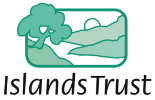Derek Kilbourn
Sounder News
The Housing Agreement for the proposed Affordable Housing development on Paisley Place has passed second and third readings at the Gabriola Local Trust Committee.
At the core of the discussion amongst Trustees was – once again – how restrictive the Agreement should be on regulating the income of those who apply to live in the development.
The file before the Gabriola LTC is entitled, “Paisley Place Housing Agreement – Proposed Bylaw No. 308”
The proposed Bylaw received first reading at the April 7, 2022 LTC regular meeting.
Proponents of the development – including the Gabriola Housing Society – say that in order to go after all potential funders, the Agreement needs to cast a wide net. Once a funder is secured, the funder will then have their own requirements on how people apply to live at Paisley Place.
Further readings for the Agreement were opposed at the April meeting by Trustee Kees Langereis, as the Agreement was not clear on how qualifying income would be determined for the low and moderate income limits.
Langereis had additional concerns that there had not been a clear enough answer from Snuneymuxw First Nation on their support for the development.
Chair Dan Rogers also voted against further readings in April, saying that staff could take the month to add more clarity around those two issues.
In the May 12, 2022 report to the LTC, Trust staff note that in May of 2021, Snuneymuxw First Nation wrote to Trust staff that the Nation does not oppose the housing project and requests the Housing agreement dedicate 25% of homes for Nation members. GHS is working to establish meetings with the Nation to continue to build relationships and develop the prioritization statement for the housing agreement.
The proposed bylaw brought to the May 12 LTC meeting contained changes made by staff to provide additional clarity that a household’s annual household income cannot exceed the ‘low’ and ‘moderate’ income limits” set by BC Housing.
The definition of low and moderate income limits will be included in definition as published by BC Housing.
Trustee Langereis asked on May 12 whether all funding would come from public organizations like BC Housing, or could there be a mixture of funding, including non-government agencies.
Ian Scott, who has been the lead planner for the Housing Society on the proposal, said there could potentially be a mixture, but if there were multiple funders, there would still be one agency taking the lead.
This lead organization (private or government) would then take the Housing Agreement, and apply their own requirements for residency in the development.
If the Housing Agreement itself is too limiting on those requirements – before a funder is found – that limits which organizations the Housing Society can look to work with.
Scott said, “It would be appropriate to have it be wider.
“We’re talking about a housing agreement with a non-profit with a particular mission. It requires collaboration amongst partners to pull this off the ground. I think getting overly caught up in this definition could be limiting in the future.
“There are intense competition amongst communities for those government dollars. But there is no guarantee. We want the flexibility to pursue a variety of funding opportunities, and it is impossible to predict what those might be.”
Chair Rogers said, “it could be a wealthy person endows a fund of $100 million for affordable housing, and you might want the flexibility to apply for that.
“Or a Credit Union comes up with a rate for affordable housing. Those would be desirable as agencies to work with, as long as their mission is for affordable housing.”
Langereis asked, “what guarantee in this whole scheme is there for people who need this housing”
“We have the service persons working for $15 to $20 an hour, what capacity will they have to rent, if rents are higher and there’s no subsidy?”
Scott said there are two ways to keep rent costs down. One is to keep the initial construction costs down through capital grants.
The other is regular annual subsidy on rent.
“I suspect BC Housing will not in the future include annual subsidies.”
“I mean, we’ve articulated this so many times. The only way to do this is thru secure funding. Setting hard targets is a sure fire way to make sure we miss that goal.”
Trustee Scott Colbourne said between the three proposed bylaws coming from the Paisley application, “we have safeguards on top of safeguards. I am supporting this.”
Langereis said, “I’m not so convinced this section works the way it is intended, I can’t support the change at this point in time.”
Chair Rogers said he understands the concerns being voiced by Langereis.
“Here’s the way I see this. I’d love to have a housing agreement that locked down what we were gong to get.
“Indeed, when we started this process I anticipated we would get a housing agreement.
“The reality is no one knows what the delivered model will look like. I’ve discovered this through discussions at BC Housing, other applicants, Trust Staff. No one knows how the funding will come about.
“I’m sure it was disappointing for the GHS to not be a successful applicant in 2021 [to BC Housing]
“What we’re hearing from the applicants is we can’t lock them down too tightly. Some of what is in the guarantee of the housing funding is going to come from the housing funder. Not from us. We won’t get to set that.”
Rogers said the real question is to ask if, “without that absolute guarantee, are we prepared to do the rezoning? Whether this housing agreement is sufficient for the compromises that 306 and 307 have in place for the rezoning.
“It is going to be hard to get specific guarantees, because that’s going to turn on what the funding looks like. I wish the cart came before the horse. But [Gabriola Housing Society] won’t get the funding if we don’t go first. We decide whether we’re prepared to accept the compromise, on the rezoning. They won’t get the funding if they don’t have the rezoning and housing agreement in place.”
Colbourne pointed out that the critically housed data for Gabriola shows just how many people are in need of homes.
“There are 60 individuals with immediate needs.”
He also said we cannot necessarily trust the ‘median’ income level for the island as telling the whole story.
“There’s this weird thing where you have people with high incomes, and a high proportion of people who need homes.”
Colbourne and Rogers voted in favour of second and third reading for bylaw 308.
The Paisley application proposes to rezone two 1 ha (2.47 acre) lots, currently zoned Institutional 3 (IN3) to an appropriate zone that allows for the development of a 24-unit multi-family affordable rental housing project.
Bylaws 306 and 307, which respectively amend the Gabriola Official Community Plan and Gabriola Land Use Bylaw, have both received three readings as well as approval from the Islands Trust Executive Committee. Only 306 requires ministerial approval – and it has received that. Both 306 (OCP) and 307 (LUB) only require final reading (adoption) from the LTC.
The adoption is dependent on 308 being approved by Executive Committee of the Islands Trust and then all three bylaws can be considered at the same time by the LTC.
The Executive Committee will be meeting on May 25, and Proposed Bylaw 308 is going forward to them for discussion. If 308 is approved by the Executive, all three bylaws could be on the agenda at the June 16 LTC meeting for consideration of final reading, and adoption.





Recent Comments